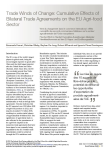Ferrari E., Elleby C., De Jong B., M'Barek R., Dominguez I.P. (2025). Trade winds of change: cumulative effects of bilateral trade agreements on the EU agri-food sector. Eurochoices, 01/08/2025, vol. 24, n. 2, p. 11-22.
https://doi.org/10.1111/1746-692X.12467
https://doi.org/10.1111/1746-692X.12467
| Titre : | Trade winds of change: cumulative effects of bilateral trade agreements on the EU agri-food sector (2025) |
| Titre original: | Vent du changement dans le commerce international : effets cumulatifs des accords commerciaux bilatéraux sur le secteur agroalimentaire de l'Union européenne |
| Auteurs : | E. Ferrari ; C. Elleby ; B. De Jong ; R. M'Barek ; I.P. Dominguez |
| Type de document : | Article |
| Dans : | Eurochoices (vol. 24, n. 2, August 2025) |
| Article en page(s) : | p. 11-22 |
| Langues : | Anglais |
| Langues du résumé : | Anglais ; Français ; Allemand |
| Catégories : |
Catégories principales 11 - COMMERCE ; 11.3 - Commerce Extérieur et InternationalThésaurus IAMM COMMERCE INTERNATIONAL ; ACCORD COMMERCIAL ; RELATIONS BILATERALES ; SECTEUR AGROINDUSTRIEL ; UNION EUROPEENNE |
| Résumé : | As one of the world's largest players in global trade, the EU pursues an open, sustainable and assertive trade strategy. The recent conclusions and ongoing negotiations of 10 European Union Free Trade Agreements (FTAs) with Australia, Chile, India, Indonesia, Malaysia, the Mercosur bloc (comprising Argentina, Brazil, Paraguay and Uruguay), Mexico, New Zealand, the Philippines and Thailand are expected to diversify the EU's agri-food trade and enhance the resilience of its food supply chain. This resilience hinges on diversifying import sources and market outlets, which can be achieved through a robust trade policy that ensures access to a sufficient supply of affordable food for citizens. A two-step modelling approach was employed to assess ex-ante the cumulative economic impact of these FTAs on food commodity trade, production, consumption and prices in 2032. The analysis reveals that both EU imports and exports increase in value in the simulated scenarios, with notable sectoral variations. On the one hand, exports of dairy products and pig meat exhibit significant growth. On the other hand, potential vulnerabilities of the EU beef, poultry meat, sugar and rice sectors are identified. The study also examines the impact of the United Kingdom's trade agenda on the EU agri-food sector, quantifying the impact of the recent agreements between the UK, Australia and New Zealand, as well as the UK's future accession to the Trans-Pacific Partnership agreement on the EU agri-food sector. |
| Cote : | En ligne |
| URL / DOI : | https://doi.org/10.1111/1746-692X.12467 |







